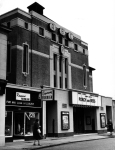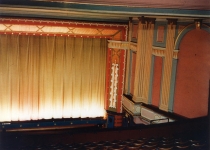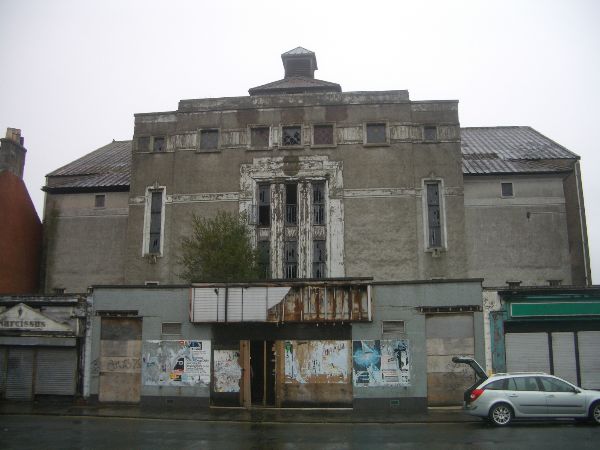Hamilton’s Regal Cinema
opened its doors in Townhead Street on August 17th, 1931. The site was
less than a minute away from the La Scala (later Gaumont) cinema in Keith Street, opened ten years previously, and would also find itself almost facing an Odeon
which would be built across the street in 1938, making for an unusually
dense concentration of the town’s main cinemas in one small area.
The Regal was initially built to the designs of Charles J McNair, and
was one of around thirty cinemas he designed over the three decades
from around 1909.
Many of these were designed as part of the
partnership of McNair and Elder, the best of which is widely considered
to have been the Ascot
in Anniesland. A third of these buildings, including the Hamilton
Regal, were commissioned by the ABC circuit, whose flagship Glasgow Regal in Sauchiehall Street was also a McNair project, completed in 1929.
A surprising number of McNair’s cinemas were rebuilds inside older buildings, such as the Bridgeton Olympia, the Kirkcaldy and Kilmarnock Regals and even parts of the Glasgow Sauchiehall Street Regal.
At Hamilton, however, he had a chance to design the whole building from
scratch, and the resulting façade would be an early example of a
style he would later return to at other Scottish sites. Externally, the cinema presents a very linear front to the street, with
no curves evident on the façade at all, a move towards the more
modernist architecture of the 1930s. |

Archive exterior,
courtesy of dusashenka
 1950s auditorium decoration, 1950s auditorium decoration,
courtesy of Kevin Gooding |

Exterior window detail

Exterior Doors

Main Foyer |
The symmetrical foyer block is set
slightly back from the main entrance doors and shops, and adopts a
style the architect would return to for later cinemas - in this case,
McNair went for the elegant solution of a large central section, with
stair towers and ancillary accommodation set increasingly further back
to the sides.
Above the main entrance, three tall, thin rectangular
windows framed the small upper foyers, with similar single windows in
the stair towers to either side. At the top, running the full width of
the central section of the block, was a band of small square windows,
filled with coloured glass. A plant room for extraction equipment
capped the main facade, with a pagoda-style roof and vent providing the
final flourish.
As mentioned, this symmetrical, linear
approach, with minimal decoration, tall central windows and box-like
elements stepped back from each other, was a style McNair was to repeat
in later work. Amongst his other ABC work, the Rex cinema in Glasgow’s
Riddrie area, opened only two months after the Hamilton Regal, and the Coatbridge
Regal, opened in 1936, are perhaps the most obvious examples of this.
Where the earlier Hamilton Regal differed from later designs, however,
was in the rather dull grey harled finish applied to the exterior.
Although the windows were outlined in brighter, lightly decorated
stonework, with two similar horizontal bands across the façade, the
grey finish detracted from what would otherwise have been an
uncluttered, clean modernist design. |
Entering the cinema through elegant wooden glazed doors, the main
ground floor foyer was fairly small, with a corner paybox and wooden
panelling on the walls and ceiling. A separate entrance for the rear
stalls was to the right of the main doors, bypassing the foyer
altogether. Stairways to the upper levels were placed to either side of
the foyer.
At the first floor level, another small foyer was decorated in a similar style, with a large star-pattern in the terrazzo floor - which strongly resembles a larger version in the main entrance foyer of McNair’s Glasgow Regal.
This earlier example has recently been uncovered and restored in the
latest redevelopment of that building – and this feature proves to be
far from the only decorative similarity between the interiors of the
two buildings.
From this first floor foyer, a single wooden-panelled vomitory deposits
patrons into the centre of the balcony, and stairs to either side again
lead to the upper levels. On a half-landing on each side, doors gave
access to where the projection box and what was presumably office space
were accommodated. Further up the main stairs also gave access to the
rear of the balcony at both rear corners.
Returning to the
ground floor foyer, the entrance to the rear stalls led to a small
vestibule, from which stairs led down to either side of the rear
stalls. This odd arrangement was a result of the sloping site on which
the Regal was built, with the auditorium being considerably lower than
the front of the building. |

Upper foyer terrazzo

Upper foyer |
On opening, the auditorium originally provided seating for around
1,800, although the balcony was swiftly extended in 1937 to provide a
total capacity of just over 2,000 (the cinema was closed between June
and September, and the work supervised by architect Alec Cullen).
Decoratively, although the exterior was a development from classical
facades of the 1920s, the interior was much more traditional, certainly
when compared to McNair’s later schemes such as the Bridgeton Olympia. Internally, Hamilton had much more in common with the classical style 1929 interior of his Glasgow Regal, with both cinemas having semi-atmospheric elements of decoration.

Exit at side of proscenium

Remains of splay wall decoration

View from projection room towards screen |
The proscenium was rectangular, the border around it being decorated
with a ribbed pattern and occasional diagonal crosses. Some more
elaborate scrollwork adorned the vertical element of the screen
opening, above the fire exits. The sidewalls, were like a smaller scale
version of those of the Glasgow Regal,
decorated with pilasters and an arch, with a pseudo-balcony front
protruding between them.
True atmospheric style cinemas had
three-dimensional decoration which would create a fantasy setting, such
as an outdoor courtyard in a foreign land, often capped by a ceiling
painted or lit to look like an open sky. Simpler, semi-atmospheric
cinemas would try to recreate these effects within the confines of more
conventional auditoriums with painted, two-dimensional decoration. In
the Hamilton Regal, the arches on either side of the splay walls
contained landscape murals, giving the effect of looking out onto a
country setting. It is like that there may also have been, as in the
Glasgow Regal, fake decorative foliage hanging from the walls and
ceiling.
Another consequence of the steeply sloping site is that
the auditorium roof is on two levels, being very much higher above the
balcony. The steep vertical face marking this change in level was
decorated with geometric features to prevent balcony patrons facing a
large blank surface area, and two deco-style chandeliers also hung from
the higher part of the ceiling. |
Despite the competition after the opening of the nearby Odeon in 1938,
the Regal soldiered on. By the 1950s, the interior décor had
been simplified, with the landscape scenes painted over, and the cinema
was renamed the ABC in 1963 as part of a nationwide move to standardise
the chain. An illuminated readograph was installed above the main
doors, and the lozenge-style individual letters of the new ABC signage
installed high up on the façade.
Sadly, in September 1976, the cinema suffered a fire in the auditorium.
The damage was extensive but certainly not irreversible, but ABC chose
to close the cinema rather than repair it. Of the triangle of cinemas
in this corner of Hamilton, the Regal had comfortably outlived the La
Scala/Gaumont, which had closed as a cinema in 1960. Ironically, the
Regal’s own closure was to prove the saviour of the ailing Odeon, which
was then later tripled and continued in operation as a cinema until
1999.
Remarkably, almost 30 years after it was last used, the
Regal still stands, decaying gently as the town centre around it is
regenerated. The interior, as well as being fire damaged, was largely
gutted at some point as part of an abandoned plan to convert it to a
nightclub.
By 2005, when the following photographic survey was made, many of the
walls and ceilings had been stripped to bare brick and concrete, and
large girders had been inserted into the front stalls to allow the
balcony to be extended fully forward to the proscenium end of the
building. Some fire and smoke damage was still evident, but despite
this, much remained of interest. |

Surviving splay wall decor

Detail of light fitting at rear of balcony |
The upper sections of the side walls still had the blackened remains of
the pseudo-balcony, pilasters and arches, with the latter containing a
vertical array of light fittings from its last makeover when a cinema.
The fire exits to each side of the proscenium were also still present,
as were large portions of the main foyer decoration.
As part of the much-heralded regeneration of Hamilton town centre, it
was inevitable that action would finally be taken with regards to the
sad shell of the Regal, and in 2005 it was compulsorarily purchased by
South Lanarkshire Council. Demolition took place in February 2006,
with the site being mooted as a temporary car park until a suitable
development scheme can be found for it. It is thanks to South
Lanarkshire Council, and in particular Stuart Hodge and his colleagues,
that the opportunity to look around the building in October 2005 arose,
and the gallery of interior photos presented here date from this visit.
 |
Click here for the full detailed photo survey (October 2005).
An exterior picture from 1993 is here, courtesy of Chris Doak. |

|
Click here for a gallery of demolition photos from February 2006, and a second gallery here from February 21st. |
References
Lanarkshire’s Legendary Cinemas, Bruce Peter, Stenlake, 1999
ABC: The First Name In Entertainment, Allan Eyles, CTA/BFI, 1993
|














